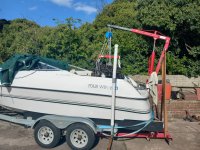Thanks for the replies and info since my last visit to the forum.
@alldodge Seems somebody intentionally wired in an engine immobiliser... not that it would take anyone who knows how to oldskool hotwire a car long to get around it.
@ScottinAZ It could be a good idea to fit a gauge directly to the engine, the one you linked to is a 'normal' aftermarket elecronic gauge though? I can easily buy senders/gauges/etc, not sure about a 'direct reading' gauge but I could wire up a gauge temporarily near the engine and check its accuracy before trusting it. Been thinking about testing the existing dash gauge and sender... take the sender out but leave the wiring connected and stick it in a pan of boiling water to see if the sender and dash gauge work.
The second hand coupler I bought arrived today, I tried it on the drive input shaft splines and it does seem tighter on the splines than my original coupler. Noticed my original coupler had 'Sierra' written in the casting, so it seems my original coupler was a replacement part anyway? The one that arrived today doesn't have the Sierra writing so is more likely to be an OEM part? The rubber in my original Sierra coupler is recessed from the rear edge/lip of the metal body by 1/4" around most of the circumference but meets the edge of the metal body at one point around the cirumference (which is why I originally tested the couple on the splines to see if the splines were aligned with the body, found the splines seemed to be aligned with the metal body but found play on the splines instead). The rubber in the coupler that arrived today is right up to the lip all around the circumference and the splines seem aligned when I turn the input shaft.
How much play should there be on the input shaft (the drive is fitted so the input shaft is obviously through the gimble bearing but the engine isn't fitted so I am able to pull up/down/left/right on the input shaft)? There does seem a bit of play on it, I don't know if that's normal or points to a problem with the gimble bearing? The gimble bearing did seem to turn smoothly when I reached inside and turned it with a finger. Is it possible to check the condition of the gimble bearing? How much of a pita to change it?
The picture below shows my old coupler (Sierra) top and the new (second hand but new to me) coupler that arrived today bottom. There doesn't seem to be much difference between them regards the splines but the splines do look a bit better on the 'new' one when looking up close, doesn't seem to look that way in the picture though.

Evinrude triple guard grease arrived since my last post, had a few deliveries but been busy with work so only opened the packages today. I also ordered an alignment tool, I don't think that's arrived yet.
I'll remember to take pics of the dash next time I'm in the boat, I only removed a small area of the rear of the boat cover to check the coupler on the splines today.
Forgot how many bolts connect the marine bell housing to the engine but think I've found those. Hoping I left the 2 nuts that hold the rear of the bell housing to the transom components inside the boat but haven't found those yet. Can anyone tell me what bolts and 2 nuts are needed in these positions in case I need to buy new ones? At least I know where the 3 small bolts that hold the back/spacer plate to the engine and the nuts that hold the flywheel and coupler to the engine are, I think... Heh this was supposed to be a quick job - Back in July I thought I'd remove the engine, fix it, put it back in the boat and be using the boat again before the end of the season. I might have remembered where I put more of the nuts and bolts if it had all gone that way.
Edit - Just thought, how do I know if grease I'm adding to trailer bearings is compatible with the grease already there...? Not so much a problem with the UJ joints because there isn't much grease on them but it will be a pita to strip and clean out the trailer bearings. Any thoughts on this grease
https://www.ebay.co.uk/itm/303898972420 ?



























